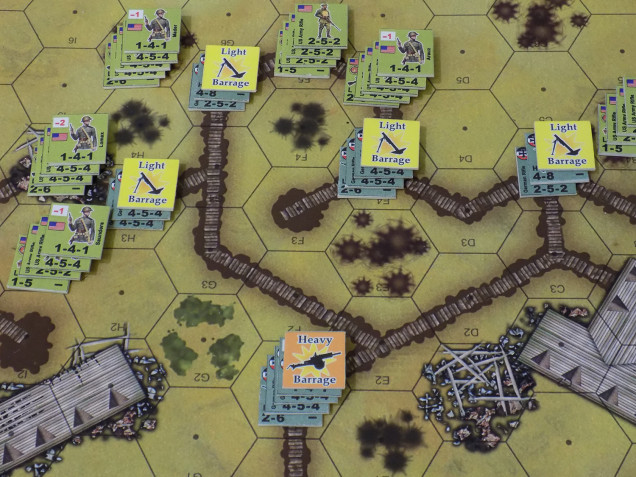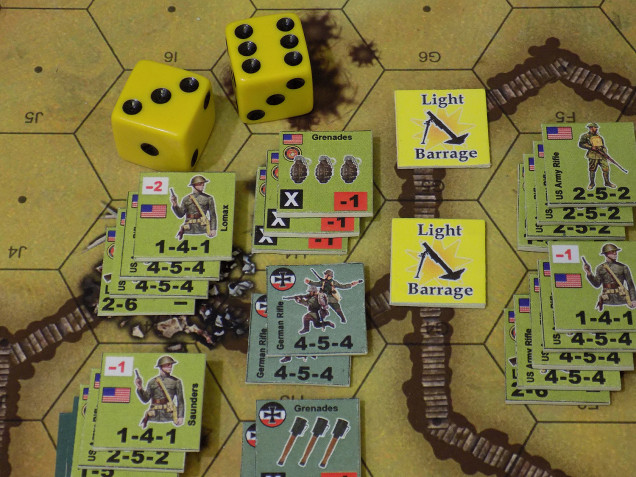Home › Forums › Historical Tabletop Game Discussions › Centennial Gaming in the Great War – Returns! › Reply To: Centennial Gaming in the Great War – Returns!
Okay, @jemmy – @torros – @elessar2590 – @neves1789 – @damon – @rasmus – et al …
So it’s finally time to kick off this battle, and see if I can “eat my own dog food” as the expression goes, and run a bonafide trench assault game for 1918 Great War.
Previous posts in this project thread have shown how the boards were drawn assembled, and the game was set up. How now it’s time to take a quick step back and lay in the American off-board artillery fire missions. A few points:
(1) The American squads have not technically made these rushes yet. They have not actually entered the board. The artillery missions are supposed to go in before the infantry arrives.
(2) This isn’t the way artillery normally works in published Valor & Victory. Remember this are WW1 rules, where not only is an on-site infantry spotter unit not required, it’s actually illegal as no one in 1918 is carrying a field radio.
(3) The normal rolls for artillery accuracy (of 1-4 for an on-target impact, 5 = I hex drift, 6 = 2 hex drift) are modified where 1-3 is an on-target hit, 4-5 = 1 hex drift, 6 = 2 hex drift. Again, this represents no radios, spotter rounds, or on-site adjustments before “fire for effect” is called.
The markers show where the artillery is intended to land.

Okay, so the artillery has gone in. Two of the four “Light Barrage” mortar salvos drifted ad hit empty fields, crafters, and trenches. Two of them hit and pretty much annihilated small German positions. The “Heavy Barrage” howitzer salvo landed on target, but only damaged some of the German units in that hex.
American squads then assaulted from the north and west. German opportunity fire was actually pretty ferocious, chewing up American assaults pretty badly. Some American 4-5-4 squads have been eliminated, some have been reduced to 2-5-2 half-squads, and some have been pinned down (inverted). One German infantry platoon at lower centre has done very well, and with a natural “2” on 2d6 not only chewed up half an American squad even though it was at extended range and in an abandoned building … but also its officer rolled sufficiently to become “Valorous.”

On the northeast board, a smaller American attack goes in, without artillery support. Fortunately, the Germans are a little more thin upon the ground here as well. Still, German opportunity fire has been deadly, and with a second “snake eyes” roll, another German squad becomes “valorous.” Note the two American assault groups at upper left are in fact in “crater” hexes, they’re not standing out in the open in front of fortified German machine guns. The crater artwork in the hexes isn’t quite big enough to show under the counters.

The first American assault goes in. Note the commander, Captain Lomax, named for @stvitusdancern of BoW fame! (82nd Airborne veteran). Each unit (including officers) can commit one grenade counter (although each army only has so many) to give a -1 bonus to their assault roll. So leading off we have Captain Lomax and two squads (one of which carries a Lewis Gun, that’s the “2-6” counter beneath is assaulting the two German 4-5-4 squads. The German trench cover does NOT count since Lomax is assaulting from within their own trench. Lomax’s combined firepower (first number is 1 + 4 + 4 + 2 = 11, vs the German 8, for 1:1 odds. That’s not great for an assault (6 or less needed on 2d6), but never fear, Lomax applies a -2 leadership bonus to this roll and they get another -3 for their grenades/. The Germans force them to add +2 for their two grenade counters. So it’s a required 6 or below on 2d6, -5, +2 for a net -3. Basically, Captain Lomax has to roll a 9 or less.
And holy hell, they barely do it. The assault is successful, and the two German squads are eliminated. However, the Americans will take additional losses in the course of this assault as well. Captain Lomax will have to choose whether to pin many of his men, “kill” only a few of them, or some combination thereof to pay for the assault.

A little further down the trench, another American assault, having already paid a steep price in opportunity fire, again barely makes the required roll for a successful assault. Note that this time the roll was an 8 or less on 2d6 instead of a 9 (slightly harder roll) because Lt. Arauz only applies a -1 bonus, not a -2. If this attack had failed (shudder – failed close assaults on fortified positions are nasty), the two American stacks at left would have gone in and finished the job.

Speaking of failed assaults, here’s one that does fail. Two full German squads (there were two 4-5-4 squads in that hex) repel the American assault on their trench. The Americans have to pay 2 casualty points (one for each German unit in the hex) + 2 for the trench bonus (note the attack was not coming in from within the German trench) + 2 for the margin by which they missed the roll (6 or below was needed, they rolled an 8). So they have to pay 6 casualty points, meaning that one whole squad is wiped out and the second squad reduced to a 2-5-2 half squad (still carrying the Lewis Gun beneath them). The Germans have to pay one casualty point for each unit that hit them, so one of their 4-5-4 squads is reduced to a 2-5-2. Basically, the Germans have lost 4 men here, the Americans lost 12.

The overall situation at the end of the American turn, after their rallies (some succeeded, some failed and so the units remained inverted). Note the Americans have largely failed to make a dent in the northeast board, but have all but smashed the German position on the northwest board. Battle has yet to really join on the southwest board, as the Americans didn’t have the movement points to get close enough on Turn 01.
On the German turn, they largely fall back and consolidate their position. Their one remaining platoon abandons the northwest board, their reorganize their squads (breaking into more half squads for better all-around defence in more directions), and their two 7.58 cm trench mortars drop a few fire missions on American platoons not in trenches (everyone’s at least in craters, but craters give a +1, while trenches give a +2.

Losses so far at the end of Turn 01. It’s pretty even, with steeper American losses thanks to bloody assaults and German opportunity fire almost perfectly equalized by that opening American artillery salvo on German positions. But now the Americans have used up their artillery. Yet their largely in the German trenches. Also, both sides have used up most of their grenades. It’s time for pistols and entrenchment tools, and time for the both sides to be much more careful in how they throw casualty points, close assaults, and opportunity fire around.








































































